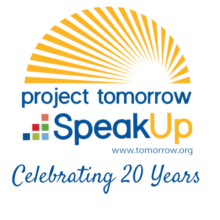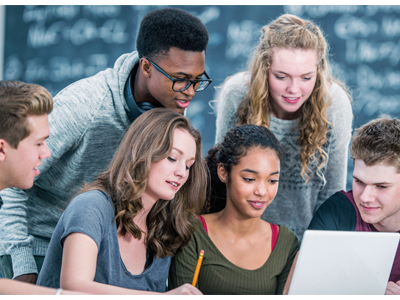20 Years of Student Feedback Drives Digital Learning
Watch the RecordingListen to the Podcast
Can you guess what students said was their most-used mobile device in 2003? Hint: It burned.
In the edLeader Panel “From CDs to AI: Congressional Briefing on 20 Years of Speak Up Research,” Dr. Julie A. Evans, CEO of Project Tomorrow and the founder of the heralded Speak Up Research Project, along with a panel of students, had a conversation about decades of trends and the latest shifts in digital learning today.
The Congressional Briefing elaborated on what students say most engages them, prevents their best work, and which device was most used 20 years ago.
Empowering the Largest Set of Student Voices
Saying “a lot has changed” is the understatement of the year. In 2014, only one in four students had direct access to technology in class. Today, 95% of high school students access schoolwork on their smartphones whenever and wherever they need it.
How did we get here? Several factors contributed, but the opinions of more than six million educators, students, and family members helped shape national school technology standards for the past two decades.
The Speak Up Research Project launched with a basic premise: Give those at school every day a voice in the future of their instruction. Dr. Evans said the Speak Up Research Project now contains the most extensive data set of student feedback existing today. The findings became foundational in the Department of Education’s annual technology plan—and have been since 2003.
The Paradigm Shifts
Technology access has monumentally increased and its purpose has evolved from ancillary classroom support to becoming the backbone of modern learning. Dr. Evans described six paradigm shifts in education, including “unfinished business”—the unabating issues ripe for new solutions and thinking.
1. Unprecedented digital ratios.
91% of teachers reported students have a 1:1 ratio to digital devices—skyrocketing up from 54% just four years ago. Yet the homework gap is still pervasive as safe, reliable internet connection outside of school remains inconsistent.
2. Technology does more than support.
Technology has evolved from the side plate to the main course, becoming the platform for learning and integral in personalizing education for every student.
3. We’ve redefined digital learning.
What began as a fun way to keep students engaged is now the basis for future-proofing and equitable learning.
4. Students recognize technology’s role in their future.
Students now focus more on the purpose of technology, intentionally seeking new technology and devices to better prepare for careers.
5. Technology kickstarted new learning journeys.
Students pursue personal interests and additional, self-directed learning outside of class, taking advantage of 24/7 content availability.
6. Students developed a vision for learning.
For the first time, students now envision ways they want to study, asking for opportunities that are socially based, contextually rich, self-directed, and untethered—accessing the wealth of information available beyond the limits of their local school, town, or school-controlled devices.
What Students Want in Tomorrow’s Classroom
Dr. Evans introduced a panel of four student experts representing middle and high school students across the U.S. to share what does and doesn’t work in their schools. Their answers echoed the research.
Asa, a high school senior from Alabama, named self-directed learning the most effective. He asked for the opportunity to be given a concept and the freedom to figure it out without prescriptively being told what to do. “You’re not always going to have someone there to hold your hand,” he said.
Finley, an eighth-grade student from Washington, emphasized collaboration. She explained students develop a “more open mind” when differing perspectives combine, leaving room for more inclusive ideas.
Bailey, an eighth-grade student from California, recommended schools become partners in time management. “It can be really demanding to schedule time in your day,” she said. Bailey anticipated juggling a career and her personal life and shared how time management is essential for every adult.
Layne, a high school junior from Kentucky, agreed. “At our school, we have flex periods, and you can pick wherever you want to go,” he said. The flex period allows students to use the time for extra work or to connect with teachers on something they may not have understood clearly in class. It also gives students agency to work on what they find most pressing.
Overall, all four students believed a blend of technology and old-school, traditional, pencil-and-paper instruction most resonated with them. They described it as the most inclusive since not everyone learns the same way.
While all student experts agreed they wanted more opportunities for collaboration in class—to learn and get to know peers—they also unanimously acknowledged the teacher could “make or break” a class. “Teachers are such a key asset,” Asa said.
So, what was students’ most-used mobile device in 2003? Students named a CD burner as the most-used mobile device in 2003 when Speak Up published its first Congressional Briefing. Before jump drives, iTunes, or Spotify, students could burn their playlist on a CD and take it anywhere, but playing it required being hardwired to a computer tower or Discman. Aghast!
Visit Tomorrow.org to review all four national briefing reports: student, teacher, administrator, and parent/family findings.
Learn more about this edWeb broadcast, From CDs to AI: Congressional Briefing on 20 Years of Speak Up Research, hosted by Project Tomorrow.
Watch the RecordingListen to the Podcast
Join the Community
21st Century Learning is a free professional learning community that serves as a forum for collaboration in a world where change is constant and learning never stops.

Article by Suzanne Bell, based on this edLeader Panel





Comments are closed.